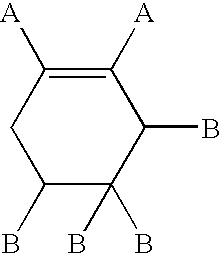Reduced antifog level in oxygen scavenging film with antifog properties
- Summary
- Abstract
- Description
- Claims
- Application Information
AI Technical Summary
Benefits of technology
Problems solved by technology
Method used
Image
Examples
example 1
[0096]
SealantOSTieNylonEVOHNylonTieBulkAdhesivePET87% PE4 + 8%90% OS1 + 10%AD280% NY1 + 20%OB180% NY1 + 20%AD2PE3AD1PET1AB1 + 3%OSMNY2NY2SX1 + 2%AF110.25 mil0.75 mil0.18 mil0.18 mil0.25 mil0.19 mil0.2 mil0.5 mil0.05 mil0.5 mil1The percentages of AF1 shown in the examples include the amount of active antifog component in masterbatch form.The antifog agent AF1 contains about 12% of a blend of glycerol and polyglycerol fatty acid ester antifog agents containingabout 50% glycerol stearate and about 50% polyglycerol stearate. Therefore in Example 1, although AF1 formsabout 2% of the sealant layer and about 0.2% of the coextruded eight-layer film structure before lamination with AD1 to PET1,the active antifog agent forms about 0.25% of the sealant layer and about 0.25% of the coextruded eight-layer film structurebefore lamination with AD1 to PET1.48 Hour UV TriggeredRefrigerated OS Rate (cc / m2 / day)AntifogAverage and Peak Values5.035.8 and 53.4
example 2
[0097]
SealantOSTieNylonEVOHNylonTieBulkAdhesivePET85% PE4 + 8%90% OS1 + 10%AD280% NY1 + 20%OB180% NY1 + 20%AD2PE3AD1PET1AB1 + 3%OSMNY2NY2SX1 + 4%AF120.25 mil0.75 mil0.18 mil0.18 mil0.25 mil0.19 mil0.2 mil0.5 mil0.05 mil0.5 mil2The active antifog agent forms about 0.5% of the sealant layer and about 0.05% of the coextruded eight-layer filmstructure before lamination with AD1 to PET1.Refrigerated OS Rate48 Hour UV Triggered(cc / m2 / day)AntifogAverage and Peak Values5.028.5 and 33.7
example 3
[0098]
SealantOSTieNylonEVOHNylonTieBulkAdhesivePET82% PE4 + 7%90% OS1 + 10%AD280% NY1 + 20%OB180% NY1 + 20%AD2PE3AD1PET1AB1 + 3%OSMNY2NY2SX1 + 8%AF130.25 mil0.75 mil0.18 mil0.18 mil0.25 mil0.19 mil0.2 mil0.5 mil0.05 mil0.5 mil3The active antifog agent forms about 1.0% of the sealant layer and about 0.1% of the coextruded eight-layerfilm structure before lamination with AD1 to PET1.48 Hour UV TriggeredRefrigerated OS Rate (cc / m2 / day)AntifogAverage and Peak Values5.034.1 and 39.2
PUM
| Property | Measurement | Unit |
|---|---|---|
| Fraction | aaaaa | aaaaa |
| Fraction | aaaaa | aaaaa |
| Time | aaaaa | aaaaa |
Abstract
Description
Claims
Application Information
 Login to View More
Login to View More - R&D
- Intellectual Property
- Life Sciences
- Materials
- Tech Scout
- Unparalleled Data Quality
- Higher Quality Content
- 60% Fewer Hallucinations
Browse by: Latest US Patents, China's latest patents, Technical Efficacy Thesaurus, Application Domain, Technology Topic, Popular Technical Reports.
© 2025 PatSnap. All rights reserved.Legal|Privacy policy|Modern Slavery Act Transparency Statement|Sitemap|About US| Contact US: help@patsnap.com

